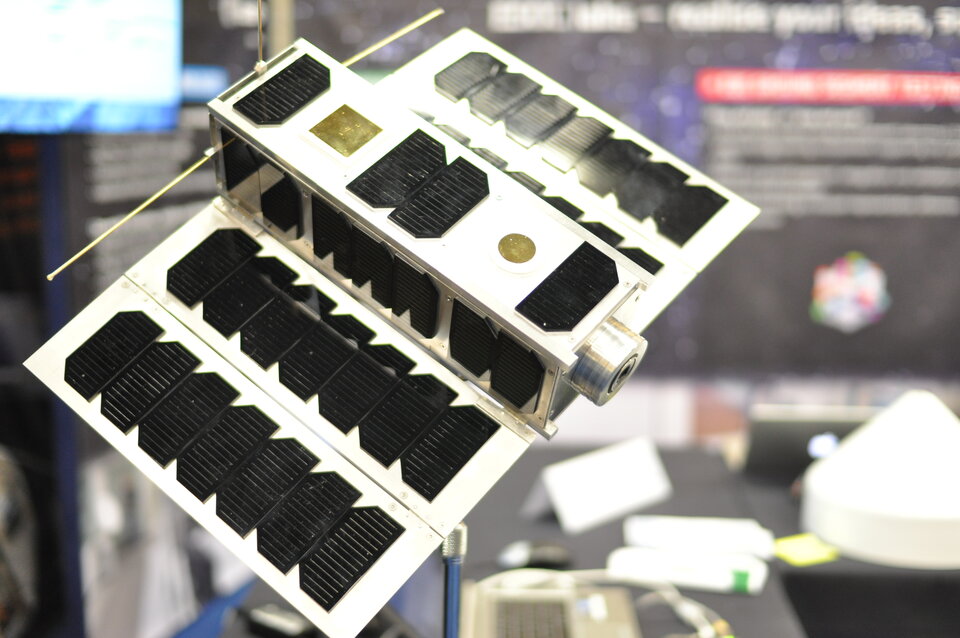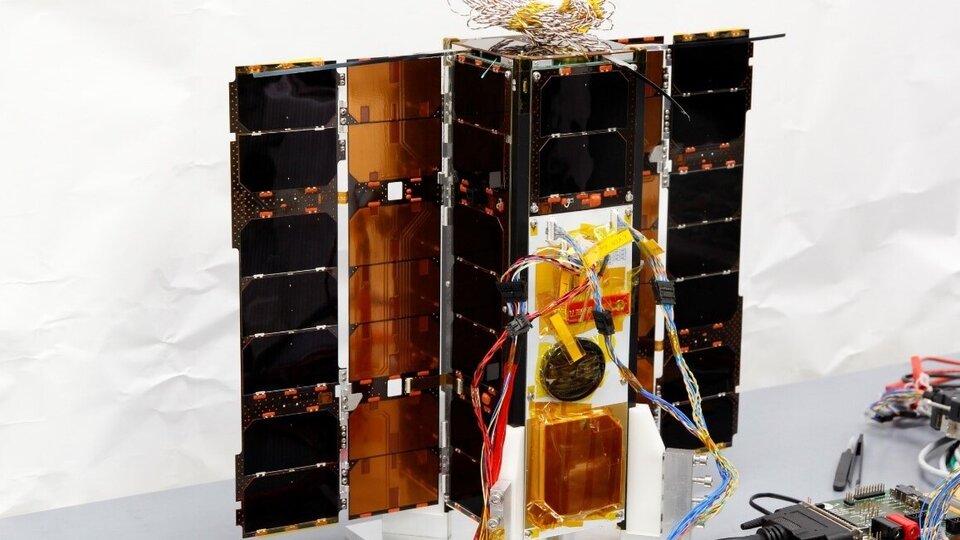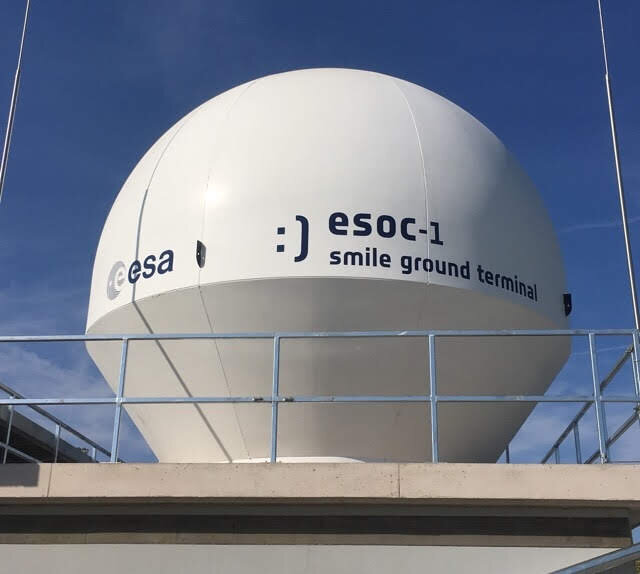Mission
OPS-SAT

A flying laboratory, ESA's OPS-SAT is the first of its kind, with the sole purpose of testing and validating new techniques in mission control and on-board satellite systems.
OPS-SAT is devoted to demonstrating drastically improved mission control capabilities, that will arise when satellites can fly more powerful on-board computers. The satellite is only 30cm high, but it contains an experimental computer ten times more powerful than any current ESA spacecraft.

It was very difficult to perform live testing of mission control systems. No-one wanted to take any risk with an existing, valuable satellite, so testing new procedures, techniques or systems in orbit was not often possible.
The OPS-SAT solution was to design a low-cost satellite that would be rock-solid safe and robust, even if there are any malfunctions due to testing.
The robustness of the basic satellite itself gave ESA flight control teams the confidence they needed to upload and try out new, innovative control software submitted by experimenters; the satellite could be pushed to its limits but could always be recovered if something went wrong.
Achieving this level of performance and safety at a low cost was a challenge. To do this, OPS-SAT combined off-the-shelf subsystems typically used with cubesats, the latest terrestrial microelectronics for the on-board computer and the experience ESA has gained in operating satellites for the last 40 years in keeping missions safe.
The result was an open, flying 'laboratory' that was available for in-orbit demonstration of revolutionary new control systems and software that would be too risky to trial on a 'real' satellite. Over 100 companies and institutions from 17 European countries have registered experimental proposals to fly on OPS-SAT.
This in-orbit laboratory offered a range of resources, including processors, field-programmable gate arrays (FPGAs), cameras, and an attitude determination and control system, all of which the experimenters were able to exploit for demonstrating new mission and operations concepts.
The OPS-SAT architecture consisted of two major parts. The first was the OPS-SAT 'bus', which provided the necessary infrastructure to operate the second part, the payload. However, in this case, once the payload was running it could take over control of the entire satellite while the bus monitored and was ready to take control back at any moment.
Payload
Processing platform
The heart of the OPS-SAT satellite payload was the processing platform, which was responsible for providing a reconfigurable environment able to fulfil the objectives of each experiment. The processing platform ran Linux, as this operating system consists of a flexible and reconfigurable framework, featuring sophisticated processing capabilities, interfaces, memory integrity and reconfigurable logic.
The platform consisted of an 'Altera Cyclone V SoC' with an ARM dual-core Cortex-A9 MPCore and a Cyclone V FPGA. OPS-SAT experimenters needed to provide bootable images for this processing platform. These images then underwent certain pre-checks before loading onto the spacecraft. Power consumption and temperature of the processing core was also being monitored by the on-board computer to provide additional safety mechanisms.
Fine Attitude Determination Control System (ADCS)
An integrated fine ADCS provided the experimenters with access to sensors and actuators as well as integrated attitude control functionality. It consisted of gyros, accelerometers, magnetometers, reaction wheels, three magnetorquers and a Star Tracker.

Global Positioning System (GPS) receiver
A GPS module was provided, so experimenters could have access to positioning data and time information.
S-Band Transponder
For high data-rate communications a CCSDS-compatible S-band communication link, acting as the main link for data communications and TM/TC with ESA ground stations, was provided. It offered uplink speeds of up to 256 kbit/s and downlink speeds of up to 1 Mbit/s. The S-band link was used to upload experimenter’s’ software and download results of on-board experiments.
X-Band transmitter
An X-band transmitter with high data-rate communications of up to 50 Mbit/s.
Camera
A high-resolution camera which provided a ground resolution of up to 80m x 80m per pixel.
Optical uplink
An optical receiver that could receive commands from a laser ranging station on Earth at an uplink rate of 2 kbps.
Software defined radio
A software-defined radio front end was provided, connected to one of the pair of diploes in the UHF antenna. The results of this experiment was made available on the processing core for further processing by experimenters, for example providing a flying spectrum analyser.
Interfaces
Experimenters were able to communicate with their flying experiments in various ways, ranging from offline file transfer only, to receiving and sending space packets in realtime with a brand new CCSDS protocol (MO services) over the internet.
Project status
The project was funded by the ESA General Support Technology Programme. This project kicked off on 4 February 2015 with the prime contractor, the Technische Universität Graz, and subcontractors.
Launch took place on 18 December, 2019, when OPS-SAT was injected into a circular, polar orbit at 515 km altitude. The spacecraft was launched as a 'secondary payload' along with the CHEOPS planet-characterising mission. OPS-SAT was controlled from the dedicated SMILE control room at ESOC.
The mission ended when the satellite deorbited on 22 May 2024.
OPS-SAT achieved several significant firsts in various areas.
Operations
- First space mission dedicated to operational technology.
- First nanosatellite directly owned and operated by ESA.[
- First in-orbit laboratory where the public can load and test software/firmware.
- First ESA mission directly controllable in real-time over the internet by the public.
- First mission to offer an on-board environment (NMF) that allows the easy development of apps for upload and execution, comparable to the concept of modern smartphones.
- First ESA mission to reconfigure an in-orbit FPGA on a daily basis.
- First mission commanded with Europe’s next-generation mission control system EGS-CC.
- First in-orbit decoding and processing of ground-based emergency beacons.
- First ground-to-space API access of an in-orbit hosted Software-as-a-Service (SaaS) application.
Artificial Intelligence
- First in-orbit neural network deployment for onboard AI.
- First onboard machine learning for in-orbit training of supervised and unsupervised models.
- First in-orbit AI model for FDIR.
- First European deep learning processing of an image using an on-board FPGA.
- First re-training of an on-board AI model with live in-flight data.
- First on-board update of an ANN (artificial neural network) in space in an institutional mission.
- First onboard Generative AI (WGANs).
- First re-use of pre-trained neural networks originally developed for terrestrial applications.
Protocols and Standards
- First ESA mission to use CFDP (CCSDS File Delivery Protocol) operationally.
- First ESA mission to use CCSDS Mission Operations Services (MO) on-board, on the space-to-ground link, and on ground.
- First in-orbit implementation of a Spacewire protocol on top of an existing LVDS connection.
- First mission to use the CCSDS Housekeeping Data Compression Standard 124.0-B-1 (based on POCKET+) on OPS-SAT-1.
Cybersecurity
- First post-Quantum KEM-TLS cryptographic solution demonstrated in-space.
- First in-orbit research platform for space cybersecurity.
Noteworthy
- First stock market transaction successfully performed in space.
- First in-orbit game of chess.
- First satellite to run DOOM in space.

